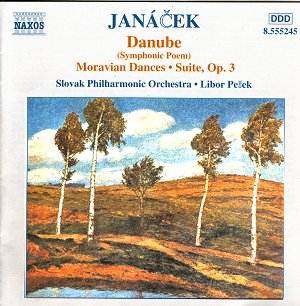Maybe Janácek was looking over his shoulder
to Vltava from Smetana’s cycle of symphonic poems Ma Vlast
(my country) when he chose the Danube for his essay in the same genre
(he certainly regarded the Danube as a Slav river, passing, as
it then did, through four Slavic states); on the other hand maybe
not! Janácek’s river is less picturesque than Smetana’s and rises
from more obscure sources. According to his pupil, Osvald Chlubna, Janácek
portrays the Danube symbolically as a woman, and the four movements
are loosely based on two poems – Lola by Alexander Insarov,
which tells of the doomed life of a prostitute who (a touch added by
the composer) eventually drowns in a river, and a narrative poem The
Drowned Girl by Pavla Kríková. Fortunately the score’s
strength and character speaks for itself, and we may dispense with such
literary pretensions and respond instinctively to its powerful musical
qualities.
Chlubna arranged the composer’s sketches for a four
movement work discovered after the composer’s death, but this recording
returns to a slightly edited transcription of the composer’s original
orchestral sketch transcribed by Leos Faltus, Milan Stedron and Otakar
Trhlik. The work falls into four sections, two fairly slow and two faster,
which fluid, impressionistic ideas that follow one another with few
obviously programmatic references except, perhaps, the fragmentary echoes
of folk music distantly heard from the river banks. The work is a kaleidoscope
of shifting colours, and the orchestration as voluptuous as it always
is in this composer’s instrumental works. In the third section Janácek
introduces a solo soprano voice singing an undulating, wordless melody,
rather in the manner of Rachmaninov’s Vocalise. Danube is
a strongly evocative work, and receives all the subtlety and expressiveness
it demands from the Slovak Philharmonic.
Schluck und Jau, is a play by Gerhardt Hauptmann
based on the Introduction to Shakespeare’s The Taming of the Shrew.
The two extracts from Janácek’s incidental music on this record
can easily be enjoyed without reference to the fantastic plot
in the same sense as Danube can do without the poems. Hauptmann’s
comedy concerns the adventures of Christopher Sly, a drunken
tinker, deceived into believing himself a lord. Shakespeare’s brief
prologue is expanded into six scenes, with plenty of dressing up and
knockabout comedy. Though these two extracts last less than ten minutes,
they earn their place on this disc by their comedic deftness.
Janácek’s reputation now resides mainly in his
operas and a few substantial orchestral works, but his dedication to
the national music of his native Moravia (now part of Czechoslovakia)
shows a more relaxed side of his musical nature. Unlike the Slavonic
and Hungarian dances Dvorak and Brahms, the Moravian dances are taken
out of the concert hall into the countryside, thus retaining their essential
freshness and simplicity. The five authentic dances on this disc are
neither overdressed nor overstressed, and treated with affectionate
respect for their rhythmic and melodic subtleties. All are delightful.
The orchestral Suite was not performed until after
the composer’s death. Its four movements contain thematic material from
an opera, The Beginning of a Romance, on which the composer was
working in 1891, partly destroyed by Janácek after its first
performance in 1894. Again ethnic influences are prominent, with an
engaging simplicity comparable to the Moravian Dances.
I rate this disc highly not only for excellent performances,
but also for its inspired rediscovery of three rarities from a Czech
composer who, in the twentieth century, can be ranked with Dvorak and
Smetana. Highly recommended.
Roy D.Brewer


